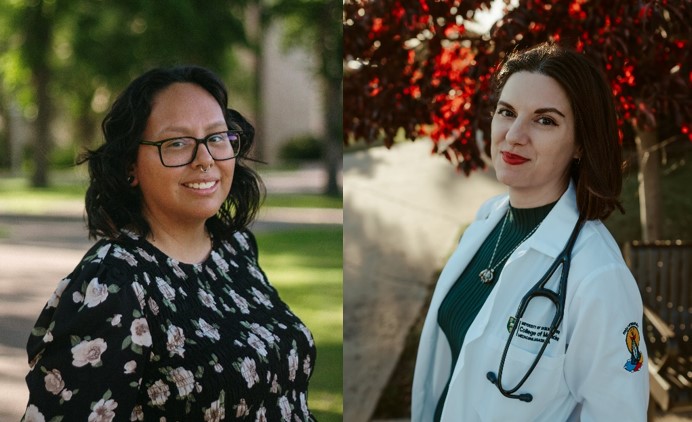
Two USask medical students develop t-shirts to raise awareness for Red Dress Day
Rebecca Seifried and Terri Thunder, two University of Saskatchewan (USask) medical students, came together to support and bring awareness to Red Dress Day by creating a special Red Dress Day t-shirt. Thunder and Seifried emphasized that “hope and strength” are the key messages that they want people to gather from their design.
By Wren MynhardtNational Red Dress Day on May 5 commemorates missing and murdered Indigenous women, girls, and two-spirit people across Canada. This day of recognition began in 2010, inspired by Jamie Black, a Métis artist from Winnipeg, Manitoba. To give voice to those who no longer had one, Black hung red dresses around Winnipeg to honour and bring awareness to missing and murdered Indigenous women, girls, and two-spirit people.
Rebecca Seifried and Terri Thunder hope the initiative behind the creation of their Red Dress Day t-shirt encourages others to reflect on the day's history and purpose. The proceeds will be donated to Saskatoon Interval House and Regina Transitional House. Seifried is a first-year medical student and the junior Indigenous health representative for the Student Medical Society of Saskatchewan. Her heritage comes from the Gakijiwanong Anishinaabe Nation, formerly Lac La Croix First Nation, in Ontario. Thunder is a second-year medical student from Thunderchild First Nation in Saskatchewan and serves as the senior Indigenous health representative. She has been extensively involved in committees and groups to support Indigenous communities and learners.
When it comes to the initial concept of these t-shirts and their importance, Thunder shared that she felt “there was more that could be done as medical students and how we can contribute.” Growing up on Thunderchild First Nation, she was taught about the prevalence of violence against Indigenous women, children, and two-spirit people from a young age, having lost her own aunt when she was ten years old. These experiences reinforced in Thunder that “having this day as a symbol is important.”
For the collaborative effort between Thunder and Seifried, Thunder envisioned the shirt as having the hand print as seen in many artistic designs behind the Missing and Murdered Indigenous Women, Girls, and Two-Spirits (MMIWG2S+) movement. However, she also wanted to include the northern lights, stating in her Nation “Northern lights are people who have passed on and are round dancing in the sky.” To her, the importance behind the Red Dress Day t-shirt design was for it to be strength based: “we wanted to acknowledge those who passed but also acknowledge they’re safe with ancestors now.”
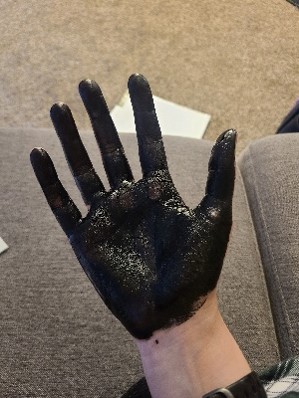
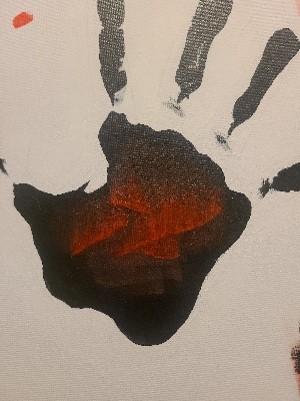
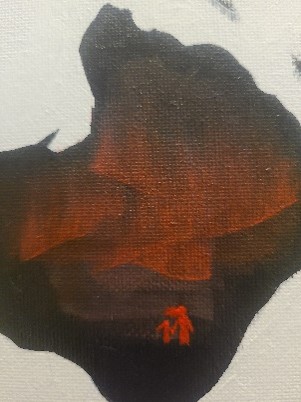
Seifried’s process on creating the Red Dress Day shirt design.
Seifried translated Thunder’s initial design concepts into the artwork. She created merged elements of hand prints, northern lights, and figures standing with one another in solidarity. “I first sketched out the ideas, and then spent nights staying up late to create the design. I even painted my hand to press against the canvas as part of the process. The handprint you see on the shirt is my own.” Seifried additionally shared with a laugh, “I spent a lot of time learning how to paint the northern lights.”
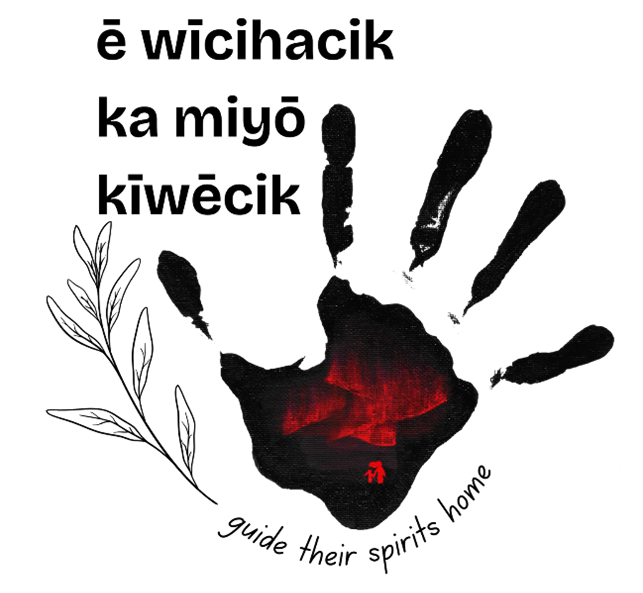
The final design resulted from Thunder and Seifried’s collaboration.
Perhaps the most powerful element on the t-shirt came from a conversation between Thunder and her mom: “I mentioned the idea to my mom and said I was looking for a phrase in Cree that encompasses that the spirits of the deceased are safe. She gave me ‘ē wīcihacik ka miyō kīwēcik’ which translates to ‘guide the spirits home.’ It comes from a song in the Ghost Dance lodge.” Thunder further explained: “The purpose of the Ghost Dance Lodge is to provide space to invite those who have passed on to join loved ones for one night in feast and dance.”
Valerie Arnault-Pelletier, the senior lead, Indigenous initiatives and programming, reflecting on this collaboration stated: “I am so incredibly proud of the Indigenous students for their dedication, and heart for our community. They both are strong leaders, humble, committed to social justice issues and strong advocates for change, not only at the community level, but in medical education at the local and national levels.”
Arnault-Pelletier also provided perspective on the wider community of Saskatoon and Saskatchewan when it comes to the MMIWG2S+ movement: “Many have been involved as activists, supporters, and leaders since the early 2000’s when we had our first community meeting at the White Buffalo Youth Lodge on 20th Street.” Arnault-Pelletier added that the network, referred to as Iskwewuk E-wichiwitochik (Women Walking Together), “was started by Monica Goulet, a Métis leader in our city and province who cares deeply about community strength and Indigenous women’s issues in particular.” One of the products of this movement and its support by subsequent leaders Darlene Okemaysim and Myrna LaPlante was a report published in 2019 titled “Iskwewuk E-wichiwitochik (Women Walking Together) Final Report, National Inquiry into Missing and Murdered Indigenous Women and Girls & Two-Spirited.”
In their final words, both Thunder and Seifried emphasized that “hope and strength” are the key messages that they want people to gather from their Red Dress Day t-shirt design.
